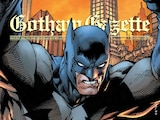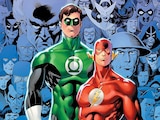For many superhero fans, reading comic books is often a struggle. Sometimes the continuity can be a pain, other times the story doesn’t go the way one expects. But as typical as these facts of the industry are, the one difficulty most endemic to the development of us as a nation is the issue of meaningful representation. Over the years, DC has implemented diversity to varying degrees of efficacy. However, 2021 saw its most powerful effort by award-winning screenwriter John Ridley and Italian artist Giuseppe Camuncoli’s The Other History of the DC Universe.
The Other History, a five-issue series, chronicles first-person accounts of various characters of color—Jefferson Pierce (Black Lightning), Mal and Karen Duncan (Herald and Bumblebee), Tatsu Yamashiro (Katana), Renee Montoya (The Question) and Anissa Pierce (Thunder)—along with real-world history.

Each issue spotlights a hero or heroes recalling their crimefighting careers in their own words, with the timeline set from the actual year they debuted. Black Lightning first appeared in 1977, so we follow Jefferson’s perspective of his life leading up to that point, throughout his time as Black Lightning, well into the 1990s during his solo series. Renee Montoya was first seen in Batman comics as part of the Gotham City Police Department, so we follow her timeline from the 1990s into the early 2010s when she becomes the second Question.
During these accounts, we’re given the heroes’ thoughts on their fellow DC colleagues, opinions on major shakeups in the various teams they were members of, such as the Outsiders and the Teen Titans, and opinions on real-world events that affected the country, speaking to their roles as superheroes and their conspicuous absences during atrocities in American history such as the Iranian hostage conflict and the murder of Vincent Chin.
It’s that latter point that underscores the rhythm of the series. By inhabiting the voices of different characters of color, Ridley displays a theme of outrage that reiterates again and again, in ways that both exemplify the truth to the heroes’ identity and their yearning to bring about meaningful justice. It’s the merging of real-world events and fictional histories that recreates the blackness of the Pierces and the Duncans, the complexities of being a queer Latina policewoman that reifies the idea of someone like Renee Montoya, and the maternal nature of Tatsu Yamashiro.

Where the writers of an older, whiter guard would cast a young renegade like Terra as a villain hired by Deathstroke, Katana would only see a teenage victim taken advantage of. Where we might see the Bat-Family and the GCPD as the “good guys,” Montoya saw them—and herself—as extensions of the state that maintained hierarchy through violence. And where Black Lightning saw himself as a tortured individual trying to do good, Anissa saw her father Jefferson as a holier-than-thou martyr whose self-righteousness blinded him to her greater potential.
The common ground running through all these accounts is that of visibility. The painful realities which speak to the history of these characters is that their perspectives were so often not regarded by the original writers. Mal and Karen discuss how painful Donna Troy’s wedding was in how it drew a huge celebratory turnout, yet not one of the Titans had shown up for their wedding. There wasn’t even an original wedding issue—it happened off-panel.
The issue becomes who considers the marriage of Herald and Bumblebee to be noteworthy, and that answer gets followed up by asking who considers Herald and Bumblebee noteworthy to begin with. Too often, characters of color are rendered in complicated ways for readers of color to believe in, either appearing in the background (sometimes with the need to squint) or disappearing entirely. The Other History of the DC Universe not only focuses on their lives, but the DC Universe in their eyes, becoming a catalyst for Ridley’s—and our—critique.

Many classic elements of the heroes’ canon are brought to the fore and put to a more critical eye. Why can’t the Justice League intervene in international conflict? Why don’t other heroes speak up for the queer members of their family? Who exactly benefits from maintaining the status quo when the ones that help maintain those parameters end up disproportionally negatively affected by it?
Despite everything, The Other History of the DC Universe isn’t a depressing book. Beyond the pessimism and the evidenced neglect of both the heroes and caretakers of the brand from decades past, the book’s very existence and unflinching exposure to these heroes, with their most personal and dimensional voices carrying us through the highs and lows of the DCU, reconstructs the universe as a more fully inhabited and believable world. It fills in the care missing from the past while making a promise for the future.

With I Am Batman (again by John Ridley), The Milestone Initiative, N.K. Jemison’s Far Sector, the recent DC Festival of Heroes: The Asian Superhero Celebration as well as the swelling of queer representation in the pages of Batman: Urban Legends and Superman: Son of Kal-El, the DC comics of today are informing and inspiring what’s to come after. John Ridley read and appreciated these disparate characters over the years, as did many of us, and used his voice to enhance theirs. It’s a celebration of DC as pure and wholehearted as any that’s been made in a long time and an absolute must for any fan of the universe, both young and old.
The Other History of the DC Universe by John Ridley, Giuseppe Camuncoli and Andrea Cucchi is now available in bookstores, comic shops, libraries and as a digital graphic novel.
Donovan Morgan Grant writes about comics, graphic novels and superhero history for DCComics.com. Follow him on Twitter at @donoDMG1.















